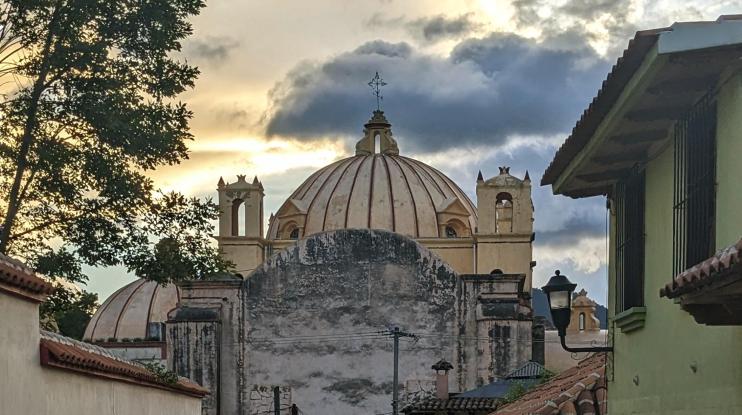Church of Santo Domingo

View from the back of the church of Santo Domingo.
The church of Santo Domingo de Guzmán in San Cristobal de las Casas
San Cristóbal de las Casas is a city located in the state of Chiapas, Mexico, distinguished by its cultural and historical wealth. Among its most emblematic buildings is the church of Santo Domingo de Guzmán, a jewel of the New Spanish Baroque that surprises with its pink façade and exuberant ornamentation.
History
The Church of Santo Domingo de Guzmán was the first Baroque church built and the most important of the Dominican buildings in Chiapas. The Dominican order was in charge of evangelizing most of the indigenous population of Chiapas since its arrival in 1545.
The Dominicans received six lots for the construction of their church and their convent in 1546, to the north of the colonial city. The first stone of the temple was placed on January 19, 1547 by the bishop of Guatemala, Francisco Marroquín. However, the work lasted for more than two centuries, due to economic and political difficulties.
The current façade was completed in 1721 and is a sample of the stipe baroque, characterized by the use of inverted pyramidal columns. The façade is covered with ornamental figures such as anagrams, mermaids, indigenous angels and vegetal fretwork, which represent the fusion between European and American cultures.
The convent attached to the temple was one of the largest and most influential in southern Mexico. Illustrious people such as Fray Bartolomé de las Casas, defender of indigenous rights, and Fray Matías de Córdova, author of the first Maya-Tzeltal dictionary, stayed here. The convent functioned until 1859, when it was confiscated and turned into a military barracks.
architecture and art
The church of Santo Domingo has a Latin cross plan with a single nave covered by a barrel vault with lunettes. The transept is crowned by an octagonal dome with a lantern. The presbytery has a golden main altarpiece with Solomonic columns and sculptures of Dominican saints. In the center is the image of Santo Domingo de Guzmán, founder of the order.
The temple has six side chapels dedicated to various Marian dedications and saints. The Rosario chapel stands out, located to the right of the presbytery, which has a Baroque altarpiece with paintings alluding to the mysteries of the rosary and a polychrome image of the Virgin of the Rosary with the Child Jesus.
Among the artistic jewels that the temple houses is the pulpit carved in a single piece of oak, which dates from the 17th century and has geometric and plant reliefs. You can also admire the valuable religious canvases that decorate the walls and altarpieces, some attributed to the Chiapas painter Juan Correa.
The former convent currently houses the Museum of the Highlands of Chiapas, which exhibits archaeological, historical and ethnographic pieces related to the region. The museum occupies several rooms of the old cloister, which preserves its original arches and fountains.
cultural significance
The Church of Santo Domingo has been a national historical monument since 1933 and is part of San Cristobal's cultural and natural heritage. It is a place of worship for the Catholic faithful and a tourist attraction for national and international visitors.
The church is also the scene of various cultural events, such as the patron saint festivals that are held every year on August 4 and 8 in honor of Santo Domingo and the Virgen del Rosario. These festivities include processions, traditional dances, music, fireworks, and craft fairs.
The church of Santo Domingo de Guzmán is undoubtedly one of the masterpieces of Mexican colonial art and a living testimony of the history and culture of Chiapas. Its beauty and its value make it an unforgettable place to know and admire.
